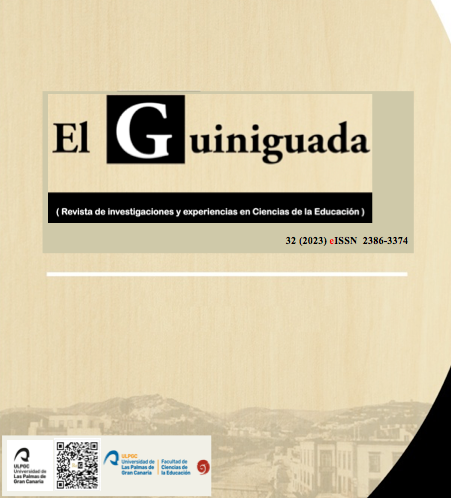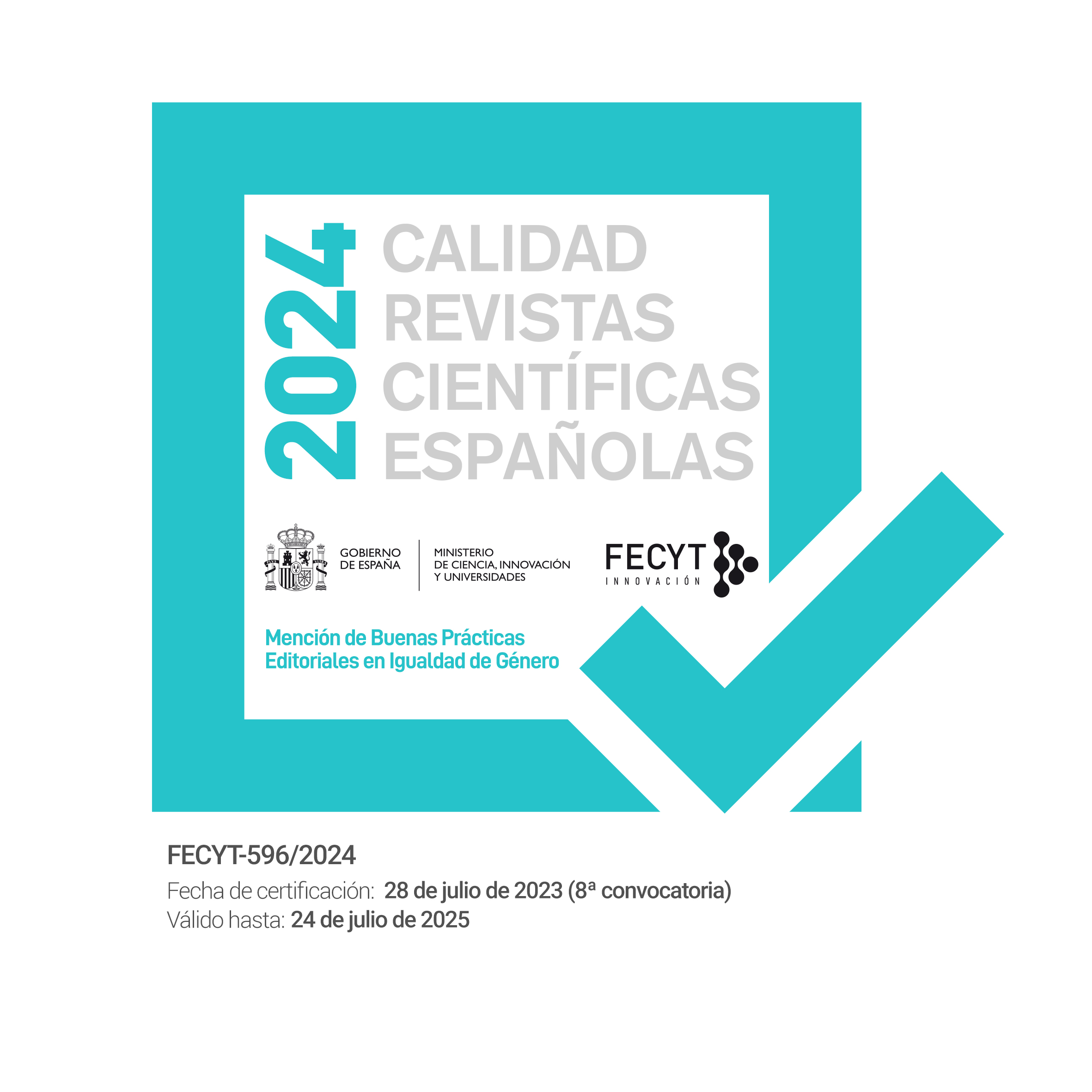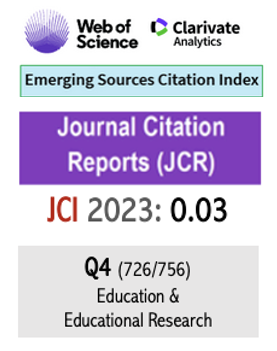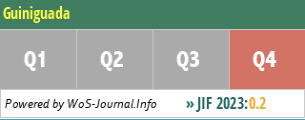Writing competence through digital cooperative learning
10.20420/ElGuiniguada.2023.634
Keywords:
escritura colaborativa en línea, aprendizaje cooperativo, destreza escrita, coautoría, escritura creativaAbstract
This writing narrates an experience of creative writing in the native Spanish language through cooperative learning (Johnson and Johnson, 1989; Slavin, 1990; Kagan, 1994; Comoglio, 1996). The pandemic imposed having classes at a distance and without being able to share materials physically, so we set ourselves the goal of innovating in methodologies for practicing written skills that were adapted to reality and allowed to continue working as a group.
In the experience collected here, an online cooperative text practice was generated for a whole group of students. The text produced was corrected as a group in class. In addition, the subject included among its continuous evaluation items the preparation of a portfolio, in which they freely and spontaneously narrate their opinions. The results demonstrate the positive impact of the activity in various aspects, namely, the development of evaluation skills, spelling, punctuation, increase in vocabulary, improvement of syntax, style, coherence and cohesion, and discursive markers, among others.
Downloads
References
Antón Cuadrado, R. & Valverde Velasco, A. (2014). Bases teóricas de la creación colaborativa de microtextos en la red: el modelo Eseeusee. Historia y Comunicación Social. Vol. 19. Núm. Especial Enero, 119-127.
Brailovsky, D. & Menchón, A. (2020). Estrategias de Escritura en la formación. La experiencia de enseñar escribiendo. Centro de publicaciones educativas y material didáctico.
Breton, A. & Eluard, P. (2003). Diccionario abreviado del surrealismo. Ediciones Siruela.
Bustos Sánchez, A. (2009). “Escritura colaborativa en línea. Un estudio preliminar orientado al análisis del proceso de co-autoría”. RIED: revista iberoamericana de educación a distancia, vol. 12, n.º 12, 33–55. <http://e-spacio.uned.es/fez/eserv.php?pid=bibliuned:revistaRied-2009-12-2-2030&dsID=Documento.pdf>. [25/02/2021].
Carlino, P. (2005). Escribir, leer y aprender en la universidad. Una introducción a la alfabetización académica. FDCE.
Casas Martín, A. L. & Nuere Menéndez-Pidal, S. (2016). El juego del cadáver exquisito, su provocadora iconografía y fundamentos de la misma. Tesis doctoral. <https://eprints.ucm.es/id/eprint/39046/1/T37757.pdf> [28/02/2021].
Chartier, R. (2000). “Muerte o transfiguración del lector”. 26º Congreso de la Unión Internacional de Editores Aires. [en línea] Disponible en: http:// jamillan.com/para_char.htm [consulta 18 de mayo 2021]
Cohen, E. G. (1999). Organizzare i gruppi cooperativi. Ruoli, funzioni, attività. Erickson.
Coll, C. (2001). Constructivismo y educación: la concepción constructivista de la enseñanza y del aprendizaje. En Coll, C.; Palacios, J.; Marchesi, A. (Comps.). Desarrollo psicológico y educación. Vol. II, 157-188. Psicología de la Educación Escolar. Alianza.
Coll, C. & Martí, E. (2001). La educación escolar ante las nuevas tecnologías de la información y la comunicación. En: Coll, C.; Palacios, J.; Marchesi, A. (Comps.). Desarrollo psicológico y educación. Vol. II, 623-651. Psicología de la educación escolar. Alianza.
Coll, C.; Mauri, T. & Onrubia, J. (2006). Análisis y resolución de casos-problema mediante el aprendizaje colaborativo. Revista de Universidad y Sociedad del Conocimiento. 3 (2), 29-41.
Comoglio, M. (1996). Cos'è il Cooperative Learning. Orientamenti Pedagogici e Sociali, 43, 259-293.
Duchamp, M. (1957). The creative act. Session on the Creative Act. Convention of the American Federation of Arts.
Ey, H. (1980 [1965]). Tratado de psiquiatría. Ed. Toray: Masson (8ª Edición, 1ª Edición 1965).
Ferreiro, E. (2004). Alfabetización. Teoría y práctica (6ª ed.). Siglo XXI.
Giraldo Giraldo, C. (2015). La escritura en el aula como instrumento de aprendizaje. Estudio en universidades, Ánfora, 22 (38), 39-58. Universidad Autónoma de Manizales.
Guzmán Tinajero, K. & Rojas-Drummond, S. M. (2012). Escritura colaborativa en alumnos de primaria: un modelo social de aprender juntos. Revista mexicana de investigación educativa, 17(52), 217-245. <http://www.scielo.org.mx/scielo.php?script=sci_arttext&pid=S1405-66662012000100010&lng=es&tlng=es> [28/08/2021].
Johnson, D. W. & Johnson, R. T. (1989). Cooperation and Competition: Theory and Research. Interaction Book Company.
Johnson, D. W.; Johnson, R. T. & Holubec, E. J. (1999). El aprendizaje cooperativo en el aula. Paidós.
Lebel, J. J. Juegos surrealistas: 100 Cadáveres Exquisitos. (1996). Ed. Fundación Colec. Thyssen-Bornemisza.
Kagan, S. (1994). Cooperative Learning. Kagan Publishing.
Kaës, R. (1977). El aparato psíquico grupal. Granica Editor.
Keys, C. W. (1994). The development of scientific reasoning skills in conjuntion with collaborative assessments. An interpretative study of 6-9th grade students. Journal of Research in Science Teaching, 3(9), 1003-1002.
Lafon, M. & Peeters, B. (2008). Escribir en colaboracion. Historias de dúos de escritores. Beatriz Viterbo Editora.
La Prova, A. (2017). La práctica del Aprendizaje Cooperativo, propuestas operativas para el grupo-clase. Narcea.
Kittle, P. & Hicks, T. (2009). Transforming the Group Paper with Collaborative Online Writing. Pedagogy: critical approaches to teaching literature, language, composition, and culture, vol. 9, 3, 525-538. <http://tccl.rit.albany.edu/knilt/images/0/07/Kittle_and_Hicks_2008.pdf>. [25/08/2021].
Lowry, P.; Curtis, A. & Lowry, M. (2004). Building a Taxonomy and Nomenclature of Collaborative Writing to Improve Interdisciplinary Research and Practice. Journal of business communication, 41(1), 66-99. <http://job.sagepub.com/content/41/1/66>. [25/08/2021].
Mejía, J. (2004). Sobre la investigación cualitativa. Nuevos conceptos y campos de desarrollo. Investigaciones Sociales, año VIII, 13, 277-299. <http://www.acuedi.org/ddata/3586.pdf>. [25/08/2021].
Morales Morales, R. y Lloret Romero, N. (2018). Experiencia de creación colaborativa en internet un cadáver exquisito 2.0 TFM, Disponible en. https://riunet.upv.es/bitstream/handle/10251/107835/MORALES%20-%20EXPERIENCIA%20DE%20CREACI%C3%93N%20COLABORATIVA%20EN%20INTERNET.%20UN%20CAD%C3%81VER%20EXQUISITO%202.0.pdf?sequence=3&isAllowed=y> [28/02/2021].
Niño-Carrasco, S. & Castellanos-Ramírez, J. (2020). Estrategias de regulación y procesos de escritura colaborativa en línea para el aprendizaje en estudiantes universitarios, Nova Scientia, 25(12, 2). 1-29. doi.org/10.21640/ns.v12i25.2499. <https://www.researchgate.net/publication/346227702_Estrategias_de_regulacion_y_procesos_de_escritura_colaborativa_en_linea_para_el_aprendizaje_en_estudiantes_universitarios> [25/08/2021].
Pujolás, P. (2009). Aprendizaje cooperativo y educación inclusiva: una forma práctica de aprender juntos alumnos diferentes. Universidad de Vic. https://www.educacionyfp.gob.es/dam/jcr:9fd29516-0a1f-426b-821e-befca46e1e15/2009-ponencia-jornadas-antiguas-pere-pdf.pdf [15/08/2021].
Pym, A. (1993). Epistemological problems in translation and its teaching: a Seminar for thinking students. Ediciones Caminade.
Salinas, C. (2012). Cadáver exquisito: utilización de redes sociales para escribir guiones de manera colaborativa y la producción de cortos audiovisuales. Tesis.
Sharan, Y. & Sharan, S. (1998). Gli alunni fanno ricerca. L’apprendimento in gruppi cooperative. Erickson.
Slavin, R. E. (1990). Co-operative learning: Theory, research and practice. Prentice Hall. Versión en español: Aprendizaje cooperativo: teoría, investigación y práctica. Aique. 1999. http://ecoasturias.com/images/PDF/slavin-el-aprendizaje-cooperativo.pdf [25/05/2021]
Storch, N. (2002). Patterns of interaction in ESL pair work. Language Learning, 52, 1, 119-158.
Storch, N. (2003). Relationships formed in dyadic interaction and opportunity for learning. International Journal of Educational Research, 37(3/4), 305-322.
Vasseur, C. & Vovelle J. (1995). Le Cadavre Exquis (1925-1975). Tesis. Historia del arte. Université Panthéon Sorbonne.
Yin, R. (1994). Case study research: Design and methods. Sage.
Published
How to Cite
Issue
Section
License
Authors who publish with this journal agree to the following terms:
- Authors retain copyright and grant the journal right of first publication with the work simultaneously licensed under a Creative Commons Attribution License that allows others to share the work with an acknowledgement of the work's authorship and initial publication in this journal. You can not make a commercial use of the work. The use derived from the work is also not allowed.
- Authors are able to enter into separate, additional contractual arrangements for the non-exclusive distribution of the journal's published version of the work (e.g., post it to an institutional repository or publish it in a book), with an acknowledgement of its initial publication in this journal.
- Authors are permitted and encouraged to post their work online (e.g., in institutional repositories or on their website) prior to and during the submission process, as it can lead to productive exchanges, as well as earlier and greater citation of published work (See The Effect of Open Access).

















